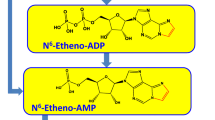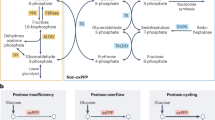Abstract
Our previous studies identified 4-pyridone-3-carboxamide-1-β-d-ribonucleoside (4PYR) phosphates in human erythrocytes. We demonstrated formation of these nucleotides by phosphorylation of 4PYR and potential toxicity due to disruption of erythrocyte energy balance. This study aimed to evaluate the ability of the other cell types to phosphorylate 4PYR to characterize function and toxicity of these compounds. Homogenates of rat heart, kidneys, and liver were used to study the rate of 4PYR phosphorylation in the presence of ATP. In another experiment, 4PYR was administered into mouse as repeated subcutaneous injections and into rats as intraperitoneal infusion. After 7 days, heart, liver, kidney, lungs, and skeletal muscle were collected, and the concentration of 4PYR nucleotides was evaluated. HPLC was used to measure 4PYR and 4PYR nucleotides in homogenate and specimens from in vivo experiments. 4PYR was rapidly phosphorylated by the liver homogenate (390 ± 27 nmol/min/g wet wt). Significant rates were reported in the heart and kidneys' homogenates: 34.3 ± 4.3 nmol/min/g and 33.2 ± 9.2 nmol/min/g, respectively. Phosphorylation of 4PYR was almost completely inhibited by adenosine kinase inhibitor 5′-iodotubercidin. Administration of 4PYR in vivo resulted in accumulation of 4PYR monophosphate in the liver, heart, skeletal muscle, and lung (20–220 nmol/g dry wt) except kidney (<1 nmol/g). In contrast to erythrocytes, no 4PYR triphosphate formation (<1 nmol/g) was observed in any of the organs studied. We conclude that not only the erythrocytes but also other cell types are capable of phosphorylating 4PYR to form 4PYR monophosphate. Potential toxicity or physiological role of 4PYR in peripheral organs could be considered, but mechanisms will be different from that in erythrocytes.







Similar content being viewed by others
References
Slominska EM, Carrey EA, Foks H, Orlewska C, Wieczerzak E, Sowinski P, Yacoub MH, Marinaki AM, Simmonds HA, Smolenski RT (2006) A novel nucleotide found in human erythrocytes, 4-pyridone-3-carboxamide-1-beta-D-ribonucleoside triphosphate. J Biol Chem 281:32057–32064
Carrey EA, Smolenski RT, Edbury SM, Laurence A, Marinaki AM, Duley JA, Zhu L, Goldsmith DJ, Simmonds HA (2003) Origin and characteristics of an unusual pyridine nucleotide accumulating in erythrocytes: positive correlation with degree of renal failure. Clin Chim Acta 335:117–129
Rutkowski B, Slominska E, Szolkiewicz M, Smolenski RT, Striley C, Rutkowski P, Swierczynski J (2003) N-methyl-2-pyridone-5-carboxamide: a novel uremic toxin? Kidney Int Suppl 84:S19–S21
Rutkowski B, Swierczynski J, Slominska E, Szolkiewicz M, Smolenski RT, Marlewski M, Butto B, Rutkowski P (2004) Disturbances of purine nucleotide metabolism in uremia. Semin Nephrol 24:479–483
Laurence A, Edbury SM, Marinaki AM, Smolenski RT, Goldsmith DJ, Simmonds HA, Carrey EA (2007) 4-Pyridone-3-carboxamide ribonucleoside triphosphate accumulating in erythrocytes in end stage renal failure originates from tryptophan metabolism. Clin Exp Med 7:135–141
Slominska EM, Orlewska C, Yuen A, Osman L, Romaszko P, Sokolowska E, Foks H, Simmonds HA, Yacoub MH, Smolenski RT (2008) Metabolism of 4-pyridone-3-carboxamide-1-beta-D-ribonucleoside triphosphate and its nucleoside precursor in the erythrocytes. Nucleosides Nucleotides Nucleic Acids 27:830–834
Smolenski RT, Lachno DR, Ledingham SJ, Yacoub MH (1990) Determination of sixteen nucleotides, nucleosides and bases using high-performance liquid chromatography and its application to the study of purine metabolism in hearts for transplantation. J Chromatogr 527:414–420
Smolenski RT, Yacoub MH (1993) Liquid chromatographic evaluation of purine production in the donor human heart during transplantation. Biomed Chromatogr 7:189–195
Sakowicz M, Grden M, Pawelczyk T (2001) Expression level of adenosine kinase in rat tissues. Lack of phosphate effect on the enzyme activity. Acta Biochim Pol 48:745–754
Pawelczyk T, Bizon D, Angielski S (1992) The distribution of enzymes involved in purine metabolism in rat kidney. Biochim Biophys Acta 1116:309–314
Acknowledgments
This study was supported by the Ministry of Science and Higher Education of Poland (NN401 2320 33 and W-189) and the European Union under the European Regional Development Fund (grant coordinated by JCET-UJ, No POIG.01.01.02-00-069/09).
Author information
Authors and Affiliations
Corresponding author
Rights and permissions
About this article
Cite this article
Romaszko, P., Slominska, E.M., Orlewska, C. et al. Metabolism of 4-pyridone-3-carboxamide-1-β-d-ribonucleoside (4PYR) in rodent tissues and in vivo. Mol Cell Biochem 351, 143–148 (2011). https://doi.org/10.1007/s11010-011-0721-9
Received:
Accepted:
Published:
Issue Date:
DOI: https://doi.org/10.1007/s11010-011-0721-9




